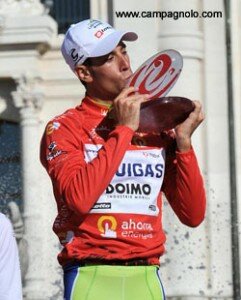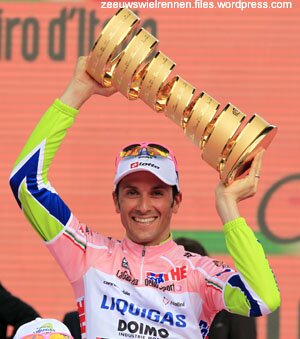January 4, 2011 by Irish Peloton
Liquigas Made History in 2010
In 2010, Liquigas didn’t win the Tour de France, they didn’t win any classics and none of their riders won medals at the World Championships, and yet they have had a remarkable year for two main reasons:
Firstly, they won two of cycling’s three Grand Tours. Ivan Basso won the Giro d’Italia, reclaiming the race for the Italians after Alberto Contador (2008) and Denis Menchov (2009) had interrupted an Italian monopoly on the race stretching back to 1997. Then Basso’s team mate Vincenzo Nibali won the Vuelta a Espana becoming the first Italian to do so since Marco Giovannetti way back in 1990, thus completing a Grand Tour double by the Liquigas team.

Ivan Basso celebrates winning the Giro for a second time having previosuly won in 2006.
Grand Tour doubles have been achieved before, and have actually been achieved by one rider instead of two. The likes of Eddy Merckx, Miguel Indurain, Bernard Hinault and Stephen Roche have all won two Grand Tours themselves in the one year. A Grand Tour double has been achieved by a single rider on 17 occasions. But in fact, a team that wins two Grand Tours in the one year with two different riders has only been done on six previous occasions.
The first team to do so was the St. Raphael team of Shay Elliott in 1962. Team captain Jacques Anquetil won the Tour de France for the third time after his German team mate Rudi Altig had won the Vuelta a Espana, becoming the first German to win a Grand Tour. The Salvarani team managed a Giro/Tour double three years later through Vittorio Adorni and Felice Gimondi. In 1977, Michel Pollentier won the Giro for his Flandria team shortly after Freddy Maertens won an incredible 13 stages on his way to Vuelta victory. Then in 1983, the almighty Renault-Elf-Gitane team won the Vuelta with Bernard Hinault despite struggling with an injury. The same injury prevented Hinault from taking part in the Tour that year, but team mate Laurent Fignon stepped up to win it at his first attempt, the last rider to do so. Incidentally, the 1983 Vuelta won by Hinault is the only Grand Tour in which Hinault, Fignon and LeMond all rode on the same team.
After 1983, there was a twenty year gap until another Grand Tour double was achieved by two team mates. In 2003, Roberto Heras, who was signed by US Postal to help Lance Armstrong at the Tour (and to prevent him from racing against Armstrong), won the Vuelta a Espana. He was afforded the opportunity of leadership of his home race after helping Armstrong win the hardest fought of his seven Tour wins. Another Armstrong team mate was involved again in 2005, when Paolo Savoldelli won the Giro d’Italia before going on to help Armstrong seal his final Tour victory.
There have been 13 riders involved in one of these team Grand Tour doubles, ten of whom raced for their fellow Grand Tour winning team mate in their other victorious Grand Tour of the year. The exceptions are Hinault, as mentioned previously he was injured for the 1983 Tour; Basso, who bore the fruit of Nibali’s efforts last May but decided to focus on the Tour rather than returning the favour at the Vuelta; and unsurprisingly, Lance Armstrong, who accepted the endless work of his team mates at the Tour, but never during his Tour winning years did he ride for somebody else in one of the other Grand Tours.

Vincenzo Nibali wins his first Grand Tour. He aims to win the Giro in 2011.
So, winning two Grand Tours in the one year with two different riders is one reason why Liquigas had a remarkable year in 2010. They became only the seventh team to achieve this. It takes a strong team with plenty of depth to be able to spread themselves adequately across two Grand Tours and to remain competitive on G.C. in both. Although it must be said, squads are far bigger now than what they once were. To provide a bit of perspective, the St. Raphael teams in the Vuelta and Tour of 1962 shared seven of the same riders, as did Salvarani in 1965. In 1977, Flandria had eight of the same riders in their two Grand Tour winning teams. In recent years this has reduced greatly, US Postal had four in 2003. In 2005, Savoldelli only had Pavel Padrnos for company in both the Giro and the Tour. Bringing us up to this year, the only rider who rode both the Giro and the Vuelta for Liquigas was Vincenzo Nibali himself.
But, the second fact about the season Liquigas had in 2010 really highlights the depth of their squad. In all three Grand Tours – Giro, Tour and Vuelta, all nine Liquigas riders finished each race. After a long slog of exhaustive research, I can confirm that this is the first time in cycling history that any team can claim this distinction.
In earlier years, there were many reasons why a single team would not have been able to achieve this feat. French teams tended to only race French races, Italian teams tended to only race Italian races etc. Then there were World and Civil Wars which meant that in some years there were only two, and sometimes only one Grand Tour raced. Then until 1962, the fact that the Tour de France was made up of national teams while the other two Grand Tours accepted trade teams continued to make the feat unlikely. There was also the fact that, unlike these days with the Vuelta in September, the three races came pretty much back to back from April to July which would have spread squads very thin indeed. It wasn’t really until the 1990s that it became common for one team to race in all three Grand Tours in the one year. But since then, no team has had all their riders finish all three races, until now.
In achieving this remarkable feat, Liquigas used 23 riders, each of whom were required to remain injury free for the duration of each Grand Tour, they had to avoid crashes, illnesses and any other afflictions. They had to continue on despite some of the hardest race routes in recent years, particularly the Giro (Liquigas were the only team to finish the Giro with a full compliment of riders). There also had to be an unwavering focus on the race at hand with nobody dropping out in order to concentrate on other goals. For instance, had Daniele Bennati been picked for the Italian Worlds squad, he may have given the final week of the Vuelta a miss. But none of these situations arose, resulting in a truly amazing achievement and the creation of a small bit of cycling history.
Edit: Throughout the course of the research I carried out for this post, I neglected to consider the recent history of Liquigas, instead (foolishly) focusing on every other team that ever existed. In light of this, some more checking revealed that Liquigas did in fact achieve this exact same feat in 2009. This means that twice in a row Liquigas have achieved something which no other team in cycling history has ever achieved even once.


Paddy Sweeney - January 6, 2011 @ 3:12 pm
Another excellent post Cillian. A great piece of research and as usual a good read. Keep up the good work.
irishpeloton - January 6, 2011 @ 5:56 pm
Thanks Paddy. Doing all that research threw up plenty of interesting stats for several more posts too. But that fact about Liquigas was definitely the most striking.